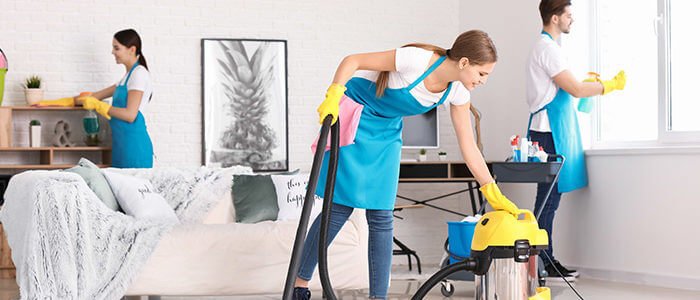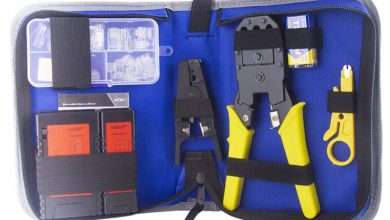Expert Tips for Cleaning and Maintaining Your Leather Suite
Understanding Your Leather Suite: Types and Characteristics

Leather suites come in various types, each with distinct characteristics that influence their care and maintenance. The most common types of leather used in furniture include aniline, semi-aniline, and pigmented (or protected) leather. We’ve put up this article with the help of Happy Clean Dublin, a reputable cleaner in Dublin. Let’s get into it.
Understanding these differences is crucial for effective cleaning and preservation.
Aniline Leather:
Aniline leather is the most natural-looking type, as it is dyed with soluble dyes without covering the surface with a topcoat. This allows the leather to retain its natural surface characteristics, such as pores and scars. However, it is more susceptible to stains and requires careful handling.
Semi-Aniline Leather:
Semi-aniline leather is similar to aniline but has a light surface coating, which provides additional protection against spills and stains while maintaining a natural appearance. This type of leather is slightly easier to clean and maintain than pure aniline.
Pigmented Leather:
Pigmented leather is the most durable and easiest to clean, thanks to its polymer coating. This coating provides uniform color and a protective layer against wear and tear, making it ideal for families and high-traffic areas. However, it lacks the natural look and feel of aniline and semi-aniline leather.
Other Types:
There are other specialized types of leather, such as nubuck and suede, which have unique textures and care requirements. Nubuck is sanded to create a velvety surface, while suede is made from the underside of the hide, giving it a soft, fuzzy feel. Both types are more delicate and require specific cleaning methods.
Understanding these types helps in selecting appropriate cleaning techniques and products. Additionally, recognizing the leather’s characteristics, such as its susceptibility to stains and scratches, allows for more effective maintenance strategies.
Knowing your leather suite’s type is the first step in preserving its beauty and longevity. With this knowledge, you can implement a regular cleaning routine that suits the specific needs of your leather, ensuring it remains in excellent condition for years to come.
Regular Cleaning Routine for Leather Suites
Maintaining the beauty and longevity of your leather suite involves establishing a regular cleaning routine. This routine should be tailored to the type of leather you have and aim to prevent the accumulation of dirt, oils, and other contaminants that can degrade the leather over time.
Weekly Dusting:
Dust your leather suite weekly using a soft, dry cloth. Microfiber cloths are ideal as they attract and hold dust particles effectively. This simple task prevents dust and dirt from settling into the leather’s pores and causing abrasion.
Monthly Wipe-Down:
Once a month, wipe down the leather with a slightly damp cloth. Use distilled water to avoid minerals that can leave residue. Ensure the cloth is not too wet, as excess moisture can damage the leather. This helps to remove light dirt and oils that accumulate from regular use.
Vacuuming:
Vacuum your leather suite monthly using a soft brush attachment. Pay special attention to crevices and seams where dust and debris can gather. This step is particularly important for suites in high-traffic areas or homes with pets, as it helps remove particles that could scratch the leather.
Deep Cleaning:
Deep clean your leather suite every six months using a leather-specific cleaner. Apply the cleaner with a soft cloth, following the manufacturer’s instructions. Test the product on an inconspicuous area first to ensure it does not discolor or damage the leather. This thorough cleaning removes embedded dirt and rejuvenates the leather’s appearance.
Avoiding Harsh Chemicals:
Never use harsh chemicals, such as ammonia or bleach, on your leather suite. These substances can strip the leather’s natural oils and cause it to dry out and crack. Stick to products specifically designed for leather care to ensure the safety and longevity of your suite.
Spot Cleaning:
Address spills and stains immediately to prevent them from setting into the leather. Blot the spill with a clean, dry cloth, avoiding rubbing, which can spread the stain. Use a damp cloth with a mild soap solution if necessary, but be sure to wipe away any soap residue with a clean, damp cloth and dry the area thoroughly.
Establishing a regular cleaning routine not only enhances the appearance of your leather suite but also extends its lifespan. Consistent maintenance prevents the buildup of damaging substances and keeps the leather supple and beautiful.
Choosing the Right Cleaning Products
Selecting the appropriate cleaning products for your leather suite is essential to maintaining its condition and appearance. Using the wrong products can cause damage, discoloration, or deterioration. Here’s how to choose the right cleaning products for your leather suite:
Leather-Specific Cleaners:
Always opt for cleaners specifically designed for leather. These products are formulated to clean effectively without stripping the leather of its natural oils. Leather cleaners come in various forms, including sprays, liquids, and wipes. Choose the one that best suits your cleaning routine.
pH-Balanced Products:
Ensure the cleaning products are pH-balanced for leather. Leather is sensitive to pH levels, and products that are too acidic or alkaline can cause damage. pH-balanced cleaners help maintain the leather’s integrity and prevent drying and cracking.
Natural Ingredients:
Consider cleaners with natural ingredients, such as beeswax, lanolin, or plant-based oils. These ingredients nourish and protect the leather while providing effective cleaning. Avoid products with harsh chemicals, as they can cause long-term damage.
Test Before Use:
Before applying any product to your entire suite, test it on a small, inconspicuous area. This test ensures the product does not cause discoloration or damage. If the test area shows no adverse effects, proceed with cleaning the rest of the suite.
Avoid Household Cleaners:
Household cleaners, such as all-purpose sprays, disinfectant wipes, and glass cleaners, should never be used on leather. These products often contain alcohol, bleach, or ammonia, which can severely damage the leather’s surface and finish.
Conditioners:
In addition to cleaners, use a leather conditioner periodically to keep the leather soft and supple. Conditioners replenish the natural oils that keep the leather flexible and prevent it from drying out and cracking. Look for conditioners that are recommended by the manufacturer of your leather suite.
Avoid DIY Remedies:
While DIY remedies, such as vinegar or baking soda, are popular for various cleaning tasks, they are not suitable for leather. These substances can be too harsh and cause more harm than good. Stick to products specifically formulated for leather care.
Read Labels and Instructions:
Always read the labels and instructions of any leather care product. Follow the recommended usage and application techniques to ensure optimal results. Overusing or misapplying products can lead to damage.
Choosing the right cleaning products is a critical aspect of leather care. With the proper products, you can effectively clean your leather suite without compromising its quality or appearance, ensuring it remains beautiful and durable for years to come.
Removing Stains and Spills Effectively
Stains and spills are inevitable, but knowing how to handle them promptly and correctly can prevent permanent damage to your leather suite. Here are expert tips for effectively removing stains and spills:
Act Quickly:
The key to preventing stains from setting into leather is to act quickly. As soon as a spill occurs, blot the area with a clean, dry cloth. Avoid rubbing, as this can spread the spill and embed it deeper into the leather.
Blotting Technique:
Use a blotting technique to lift the spill from the surface. Press a cloth gently against the spill to absorb as much liquid as possible. Repeat with a fresh cloth until no more liquid is absorbed.
Mild Soap Solution:
For water-based spills, such as juice or coffee, use a mild soap solution. Mix a small amount of mild, pH-balanced soap with distilled water. Dampen a cloth with the solution and gently wipe the affected area. Follow with a clean, damp cloth to remove any soap residue, and dry the area thoroughly.
Ink Stains:
Ink stains can be particularly challenging to remove. Use a cotton swab dipped in rubbing alcohol to dab the stain lightly. Be cautious and test on an inconspicuous area first. Once the stain lifts, clean the area with a damp cloth and dry it.
Oil and Grease Stains:
For oil-based stains, such as butter or salad dressing, blot the excess oil with a dry cloth. Sprinkle talcum powder or cornstarch on the stain and let it sit for several hours to absorb the oil. Gently brush off the powder and clean the area with a damp cloth if needed.
Avoid Excessive Moisture:
Leather is sensitive to moisture, so avoid using too much water when cleaning spills. Excessive moisture can cause the leather to swell or crack. Always use a slightly damp cloth and dry the area thoroughly after cleaning.
Commercial Stain Removers:
If home remedies are not effective, consider using a commercial leather stain remover. Follow the product’s instructions carefully and test on a small area first. These products are formulated to tackle tough stains without damaging the leather.
Professional Help:
For stubborn or large stains that do not respond to at-home treatments, seek professional help. Professional leather cleaners have specialized tools and knowledge to safely and effectively remove difficult stains.
Regular Maintenance:
Regular maintenance can help prevent stains from becoming a major issue. Condition your leather suite periodically to keep the leather supple and less prone to absorbing spills. A well-maintained leather suite is more resistant to stains and easier to clean.
By following these tips, you can effectively manage spills and stains, preserving the beauty and integrity of your leather suite. Quick action and the right techniques are essential to preventing permanent damage and maintaining the leather’s pristine condition.





